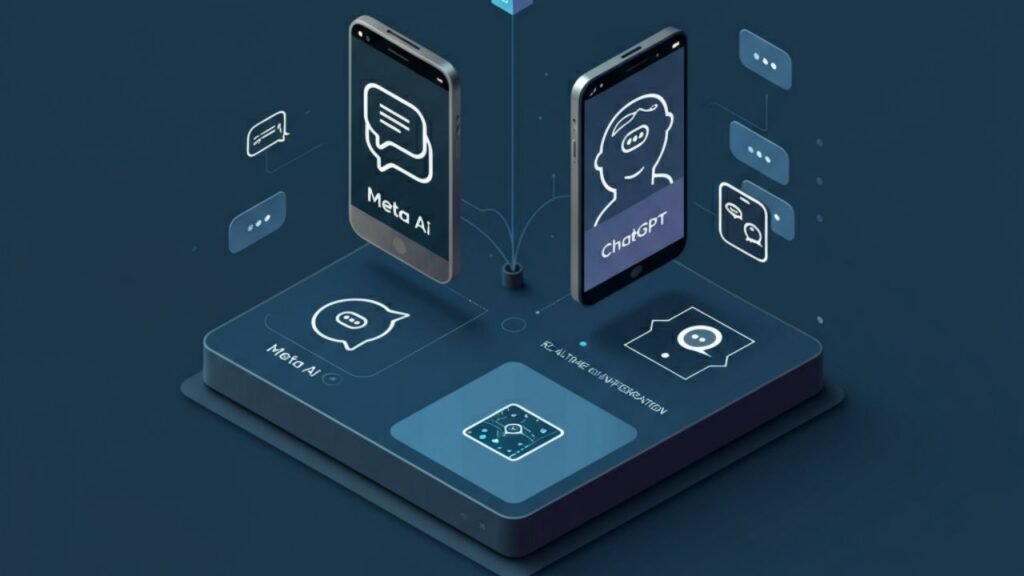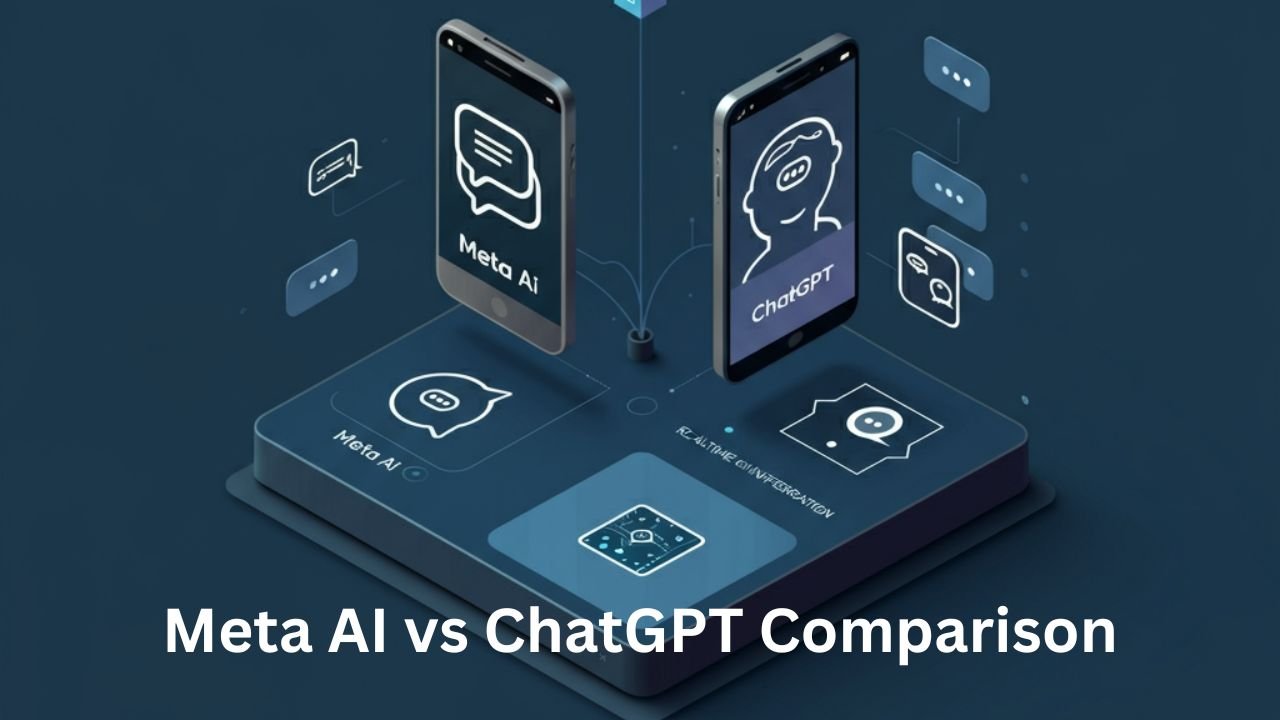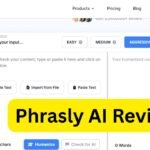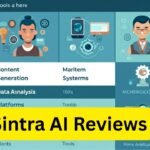Meta AI vs ChatGPT Comparison
The world of artificial intelligence is moving at an incredible speed. Two names that constantly appear in headlines are Meta AI and ChatGPT. Both are powerful language models that can write, translate, code, and have human-like conversations. But while they might seem similar on the surface, they have distinct differences in their design, features, and intended use.
This detailed Meta AI vs. ChatGPT comparison will explore their features and capabilities. We will look at what makes each model unique, where they excel, and how they are shaping the future of AI. Whether you’re a student, a professional, or simply curious about this technology, this guide will provide a clear understanding of these two AI giants.
What is ChatGPT?
ChatGPT, developed by OpenAI, is a large language model (LLM) that burst onto the scene in late 2022 and quickly became a household name. It is built on OpenAI’s Generative Pre-trained Transformer (GPT) architecture. Think of it as a highly advanced chatbot designed to understand and generate human-like text in response to a wide range of prompts and questions.
The core function of ChatGPT is to process natural language. You can ask it a question, give it a command, or provide it with a piece of text to analyze. It then uses its vast training data—a massive collection of text and code from the internet—to produce a relevant and coherent response.
Initially, ChatGPT was primarily a text-based tool. Users interacted with it through a simple chat window. However, it has evolved significantly. Newer versions, like GPT-4o, can now understand and respond to images, voice, and documents. This makes it a multi-modal tool capable of handling more complex tasks.
OpenAI offers both a free version of ChatGPT, which is highly capable, and a paid subscription service (ChatGPT Plus, Team, and Enterprise). The paid versions provide access to more advanced models, faster response times, and additional features like data analysis, image generation with DALL-E 3, and web browsing capabilities.
What is Meta AI?
Meta AI is the artificial intelligence division of Meta, the company behind Facebook, Instagram, and WhatsApp. While Meta has been a major player in AI research for years, its conversational AI assistant, also called Meta AI, represents a significant step into the consumer space. It is powered by Llama 3, Meta’s latest and most powerful open-source large language model.
A key difference in the ChatGPT vs. Meta AI comparison is integration. Meta AI is deeply woven into the fabric of Meta’s social media and messaging apps. You can find it in the search bars of Facebook, Instagram, Messenger, and WhatsApp. This integration means billions of users can access a powerful AI assistant without needing to download a separate app or visit a different website.
Meta AI is designed to be more than just a question-and-answer machine. It aims to be a helpful assistant that can assist with social planning, provide real-time information, and generate images right within your chats. For example, you can ask Meta AI to find restaurants for a group outing and share the results directly in a Messenger group chat.
One of the most notable aspects of Meta AI is its use of real-time information. It partners with search engines like Google and Microsoft Bing to pull up-to-date results, which helps it avoid providing outdated or incorrect information—a common issue with some earlier AI models.

ChatGPT vs. Meta AI Capabilities Comparison
To truly understand these two models, we need to compare their core capabilities. While both are excellent at conversation and text generation, their strengths and weaknesses become clear when we look closer at specific functions.
1. Underlying Model and Architecture
ChatGPT: The power behind ChatGPT is OpenAI’s GPT series of models. The free version typically runs on a model like GPT-3.5, while subscribers get access to the more advanced GPT-4 and GPT-4o. These models are known for their exceptional reasoning, creativity, and nuanced understanding of language. OpenAI’s models are proprietary, meaning the code and full details of their architecture are not publicly available. This “closed-source” approach gives OpenAI tight control over its development and use.
Meta AI: Meta AI is powered by Llama 3, the latest generation of Meta’s open-source LLMs. The term “open-source” is crucial here. Meta makes the model weights and some of the code available to the public, allowing researchers, developers, and other companies to build upon, modify, and study it. This fosters a community-driven approach to AI development and safety. Llama 3 was designed to be a top-tier model, competitive with the best proprietary models on the market in terms of performance and reasoning.
2. Access to Real-Time Information
This is a major point in the Meta AI vs ChatGPT comparison features capabilities.
ChatGPT: The free version of ChatGPT has a knowledge cutoff, meaning its training data only goes up to a certain point in time (for example, early 2023). If you ask it about events that happened after that date, it won’t know the answer. However, paid subscribers using the GPT-4 model have a “Browse with Bing” feature. This allows ChatGPT to access the internet to find current information, making it much more useful for questions about recent news, events, or data.
Meta AI: Meta AI was designed from the ground up to provide real-time information. Through its partnerships with Microsoft Bing and Google, it can access the internet for every query. When you ask Meta AI a question, it can provide up-to-the-minute answers, complete with source links. This makes it incredibly reliable for tasks like checking the latest sports scores, finding news headlines, or getting real-time weather updates. This feature is available for free to all users.
3. Integration and Accessibility
ChatGPT: ChatGPT is primarily a standalone product. You can access it through its website (chat.openai.com) or a dedicated mobile app for iOS and Android. While it offers APIs for developers to integrate its capabilities into other applications, the primary user experience is centered on its own platform. This makes it a destination tool—you go to it when you have a specific task in mind.
Meta AI: Meta AI’s greatest strength is its seamless integration into products that billions of people already use every day. It’s built into the search and chat functions of Facebook, Instagram, Messenger, and WhatsApp. This “in-context” availability means you can call on the AI without leaving your current activity. You can be planning an event in a WhatsApp group and ask Meta AI for suggestions right there in the chat. This approach removes friction and makes advanced AI accessible to a massive, non-technical audience. Meta also offers a standalone website (meta.ai) for a more focused chat experience.
4. Image Generation
Both models have impressive text-to-image generation capabilities, but their approach and features differ.
ChatGPT: Paid subscribers can use DALL-E 3, one of the most advanced image generators available. DALL-E 3 is known for its ability to understand complex, detailed prompts and produce highly creative and coherent images. A unique feature is its integration with the chat interface. You can ask for an image and then conversationally request edits. For example, you can say, “Make the dog in the picture a golden retriever,” and it will generate a new version based on your feedback.
Meta AI: Meta AI’s image generation feature is called “Imagine with Meta AI.” It is incredibly fast, generating images in near real-time as you type your prompt. You can watch the image evolve with each word you add. This feature is also free and integrated directly into messaging apps. You can type /imagine in a WhatsApp chat to create and share an AI-generated image instantly. While it’s very fast, some users find that the quality or prompt adherence might not be as consistently high as DALL-E 3 for very complex requests.
5. Tone and Personality
ChatGPT: By default, ChatGPT adopts a helpful, neutral, and somewhat formal tone. It’s designed to be a reliable and knowledgeable assistant. While you can instruct it to adopt different personas or writing styles (e.g., “Write this in the style of a pirate”), its core personality is professional and direct.
Meta AI: Meta has put a lot of effort into giving Meta AI a more distinct and engaging personality. It’s often more conversational, using emojis and a more casual tone. Furthermore, within Meta’s apps, you can interact with different AI “characters.” These are versions of Meta AI with unique personalities and interests, portrayed by celebrities and influencers like Snoop Dogg, Tom Brady, and Kendall Jenner. This makes interactions feel more dynamic and less like talking to a machine.
Comparison Table: Meta AI vs. ChatGPT
| Feature / Capability | Meta AI (powered by Llama 3) | ChatGPT (powered by GPT-3.5/GPT-4/GPT-4o) |
|---|---|---|
| Underlying Model | Llama 3 (Open-Source) | GPT-3.5, GPT-4, GPT-4o (Proprietary/Closed-Source) |
| Primary Access | Integrated into Facebook, Instagram, Messenger, WhatsApp; Standalone website (meta.ai) | Standalone website (chat.openai.com) and mobile apps |
| Cost | Free to use | Freemium model. Free version with limitations; Paid plans (Plus, Team, Enterprise) for advanced features |
| Real-Time Information | Yes, fully integrated with Google and Bing search for all users (free) | Limited in the free version (knowledge cutoff). Available for paid users via “Browse with Bing” |
| Image Generation | Yes, “Imagine with Meta AI.” Generates images in real-time as you type. Free. | Yes, via DALL-E 3 integration for paid users. Allows for conversational edits. |
| Voice Capabilities | Yes, voice conversations are supported in apps. | Yes, voice conversations are supported in mobile apps. GPT-4o enhances this significantly. |
| Integration Ecosystem | Deeply integrated into Meta’s ecosystem of social and messaging apps. | Primarily a standalone tool. Offers APIs for third-party integration. |
| Open-Source vs. Proprietary | Open-source. Encourages community development and transparency. | Proprietary. OpenAI maintains full control over the model’s development and use. |
| Conversation History | Can save and reference past conversations. | Can save and reference past conversations. Allows users to turn history off. |
| Personality | More conversational and casual by default. Offers multiple AI “characters” with distinct personalities. | Generally neutral, formal, and assistant-like. Can be prompted to adopt different personas. |
| Coding Assistance | Capable of generating and debugging code. Strong performance from Llama 3. | Highly capable of generating, explaining, and debugging code, especially with GPT-4. |
| Multimodality | Can process text and generate images. | Can process text, images, audio, and documents (especially with GPT-4 and GPT-4o). |
Use Cases: When to Use Meta AI vs ChatGPT
The best choice between Meta AI and ChatGPT often depends on what you need to do. Here’s a breakdown of scenarios where one might be more suitable than the other.
Choose Meta AI for:
- Social Planning and In-App Assistance: If you’re already in WhatsApp or Messenger and want to find a recipe, look up a movie time, or settle a debate in a group chat, Meta AI is the perfect tool. Its integration means you don’t have to switch apps.
- Quick, Real-Time Information: For any question that requires up-to-the-minute information, Meta AI is a fantastic free option. Checking sports scores, finding breaking news, or looking up stock prices are all tasks where its real-time web access shines.
- Fast and Fun Image Generation: If you want to quickly create a fun image to share with friends, the real-time generation of “Imagine with Meta AI” is hard to beat. The speed and ease of use make it great for casual creative tasks.
- Casual Conversation and Brainstorming: The conversational tone and character options can make brainstorming with Meta AI feel more natural and engaging for some users.
Choose ChatGPT for:
- In-Depth Content Creation: For writing long-form content like articles, essays, or detailed reports, ChatGPT’s advanced models (GPT-4) often produce more structured and nuanced text. Its ability to maintain context over long conversations is a significant advantage.
- Complex Problem-Solving and Coding: Developers and students often prefer ChatGPT for its powerful logic, reasoning, and coding capabilities. It can debug complex code, explain programming concepts, and write extensive scripts.
- Creative and Technical Writing: When you need a specific tone, style, or format, ChatGPT’s ability to follow complex instructions makes it a superior tool for professional and creative writing tasks.
- Advanced Data Analysis: ChatGPT Plus subscribers can upload documents (like spreadsheets and PDFs) and have the AI analyze the data, create charts, and provide insights. This is a powerful feature not currently offered by Meta AI in the same way.
- High-Quality, Editable Image Generation: For artists, designers, or anyone needing a high-quality image from a detailed prompt, DALL-E 3 via ChatGPT is the industry leader. The ability to refine the image through conversation is a unique and powerful feature.
The Future of the AI Race
The ChatGPT vs. Meta AI capabilities comparison is not just about a single moment in time; it’s about two different philosophies for the future of AI.
OpenAI, with ChatGPT, is building a powerful, general-purpose intelligence that serves as a destination for complex tasks. Its business model is focused on providing premium, cutting-edge AI capabilities to individuals and businesses willing to pay for the best performance.
Meta, on the other hand, is pursuing a strategy of mass distribution and integration. By embedding a very capable, free AI into the apps people already use, it aims to make AI a seamless and ubiquitous part of daily digital life. Its open-source approach with Llama 3 also aims to democratize access to powerful AI, accelerating innovation across the industry.
Conclusion
So, which AI is better? The answer is that there is no single “best” AI. The Meta AI vs. ChatGPT comparison shows us that they are both exceptional tools with different strengths, designed for different purposes and user experiences.
Meta AI excels in convenience, real-time information, and social integration. It is the perfect everyday assistant, ready to help within the apps you use most, all for free. Its speed and ease of use make advanced AI accessible to everyone.
ChatGPT, particularly its paid version, remains the powerhouse for complex, specialized tasks. Its superior reasoning, in-depth content creation, and advanced features like data analysis and high-fidelity image generation make it the go-to choice for professionals, creators, and anyone pushing the limits of what AI can do.
Ultimately, the competition between Meta AI and ChatGPT is a win for all of us. It drives innovation, pushes the boundaries of technology, and provides us with a growing array of powerful tools that can enhance our work, creativity, and daily lives. The best approach is to try both. Use Meta AI for your quick questions and social planning, and turn to ChatGPT when you need a deep, creative, or analytical partner for a more demanding project.










